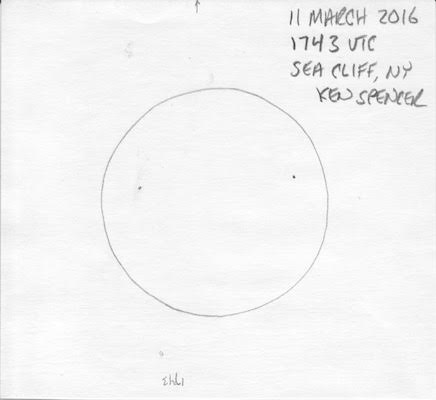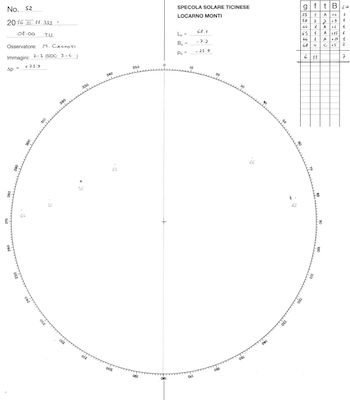A Simple but Very Interesting Project in Sunspot Observation

length, built by Ken Spencer, of Sea Cliff, NY. The scope
uses the projection method and the plate that holds the
paper is the white square to the lower left. No solar filter
is used for this method.
Note: Dr. Leif Svalgaard passed away October 2, 2025. Since Dr. Svalgaard's death, Nicolàs de Hilster is working on the continuation of this project. Please contact him regarding drawings, questions, etc. The text of this page has not been altered to reflect Dr. Svalgaard's death except to remove his email address and substitute Nicolàs de Hilster's name re making email contact about the project.
Understanding our Sun's long-term magnetic cycle is among the central concerns of solar physics. While modern observations have become very sophisticated, the simplest historical records of solar activity remain significant. Solar physicist Dr. Leif Svalgaard is among the world's leaders in the field of solar records. A concern, however, was how it might prove necessary to adjust interpretation of a key series of 1,130 sunspot drawings recorded by German amateur astronomer Johann Caspar Staudach that were made between 1749 and 1799.
To better interpret Staudach's drawings, it occurred to Svalgaard that current solar activity could be observed with telescopes similar to the 18th century one used by Staudach. To that end, Svalgaard appealed to the Antique Telescope Society in 2015 to recruit observers able to use 18th century telescopes or simple reproductions of what such instruments were.
As it turned out, very few ATS members had early telescopes available. But it proved easy to make reasonable reproductions of what Staudach used. The German amateur did not record details of his telescope. In fact, he said nothing more about it than referring to it as a "three-foot sky tube." But we can reasonably assume it used a single-element objective having a focal length of about a meter, and the drawings were made using eyepiece projection. Compared to modern standard sunspot counts, only a fraction of the actual spots are recorded with such simple equipment. Understanding that fraction is key to a correct interpretation of Staudach's record!
- Find telescopes (from the 18th century if possible) with characteristics similar to Staudach’s
- Find people willing to observe, i.e. make drawings of what they see (high precision of positions is not needed)
- Make systematic observations over some time (months, or as long as possible) even if only one drawing per week
- If we can find several people or more, they can share the load, and also make it possible to assess the "error bar"
- Observers can scan the drawings and communicate them to me (Leif Svalgaard, now Nicolàs de Hilster). Website: https://www.leif.org/research
- I’ll process the drawings and produce a scientific paper with the observers as co-authors, publishing the result
- Benefits: Exposure for everyone participating, while building an important calibration point for the Sunspot Series (real science!)
Initial observers in the project included John W. Briggs, Ken Spencer, and Walter Stephani, all with homemade reproduction telescopes. Briggs described his experience making his telescope as follows:
The outline for a suitable telescope for the reenactments is necessarily vague. While I still hope to get my hands on an original 18th century "three-foot sky tube," I decided to begin by building something simple from scratch. Perhaps too hasty in my prejudice toward old-time standards, my goal was to build something appropriately rude & despicable. Surplus Shed sold "PL1107," a 30-mm uncoated plano-convex lens, 1,000-mm focal length, for $5. That seemed like a reasonable choice for my re-creation objective glass.
I took my objective and glued it unceremoniously into the middle of a large steel washer. I then glued the washer to one end of a reasonably stout mailing tube of good length. I considered all this a fine start toward an appropriately rude 18th century sky-tube approximation.
I then chose an anonymous and undistinguished eyepiece from my optical junque catacomb -- an old, small, uncoated two-element ocular of about 1/2-inch focal length. I did not bother to clean it well, in part because I can't open it easily. Another step in the right direction, I thought. After gluing, the clear aperture of my sky tube became about 3/4-inch, so the focal ratio became about f/52.
I was briefly confounded by the problem of a drawtube. I resorted to borrowing a brass one from the Allegheny College 7-inch Clark, circa 1865, the most convenient thing at hand. With quite a number of layers of taped paper to form a collar adapter, the instrument took form, and I got first light through a living room window. The weather was poor, but the telescope worked!
Soon I got a bright clear day and was surprised how well the telescope showed basic sunspots by eyepiece projection. My final step, before I started making solar drawings about 3 inches in diameter, was to attach the tube to a tiny equatorial and devise something to hold paper behind the eyepiece.
At that point in my project, we were hit with a major snowstorm. Snowed-in with 20 inches, we woke early to a very bright morning. The view though our westward window offered countless fantastic artificial stars, glinting from up close to hundreds, if not thousands, of feet away, across a valley. I devised a loop of string to hold the telescope's front end near the window, and I hand-held the other end. The air outside was evidently very still.
I guess I shouldn't have been so surprised to be rewarded by the sight of hundreds of Airy disks. No matter that it was a non-achromatic single-lens telescope and a dirty old eyepiece (and through a window) -- the disks & first-order diffraction rings looked great! My "rude and despicable" telescope was thus a failure. It worked great!
I hope other people will consider building similar "sky tube" replicas.

Unfortunately the inexpensive $5 lens used by Briggs is no longer available. But any simple lens of about 1-meter focal length would be fine. Ideally it should be uncoated. "One diopter" lenses (meaning a focal length of one meter), as used in eyeglasses, would be fine. Edmund Optics has a 750-mm focal length lens (stock #45-282) that would be a good focal length to add to the reproduction telescopes involved in this project. If the lens has a large diameter, as likely the case if made for optometry, it should be stopped down with a mask to about a 1/2- to 3/4-inch aperture. The eyepiece should not matter much, but a very simple one would be best, such as any older 2-element type of about 12- to 26-mm focal length. A draw-tube focuser, possibly using PVC plumbing parts, should allow a projected image of the Sun to be made with about a 3-inch diameter.
Ideally, new observers participating in this project will have telescopes slightly different from the reproductions already in use. Briggs chose a standard 3-inch diameter for his drawing size. Staudach made only 2-inch-diameter drawings. There is no need to record positions with great accuracy, as Dr. Svalgaard is interested in only approximate position and intensity of what's seen. Barely perceived details of penumbral structure, for example, are not necessary to record. Note also that it is wise to pursue this project ignorant of what larger modern telescopes are showing of the sunspot distribution! (This point may make the project difficult for people involved in other solar observations, as they'll be forewarned what to expect.)
Anyone interested to pursue this project can contact Nicolàs de Hilster for general information and encouragement and John W. Briggs for suggestions on the technical aspects of building a reproduction 18th century telescope. John's article describing the considerable scientific interest Leif has generated is in the March, 2021, issue of the Astronomical League's quarterly magazine, Reflector, pages 24-25, "A Funny Thing Happened in Solar Physics." A great deal of additional information can be found on Leif's research website, mentioned above.
Read Ken Spencer's personal reflections on this project.

|

|

